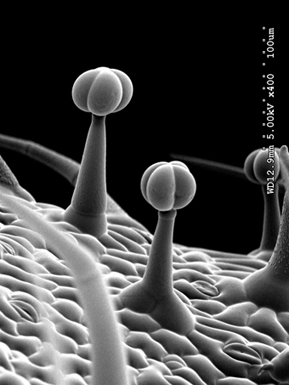Research: Project 3
Glandular Trichomes in the Solanum
Glandular trichomes (GTs) populate the aerial surfaces of approximately 30% of all vascular plant species. These uni- and multi-cellular appendages play a critical role in plant protection against insects, and various abiotic stress conditions as well. A remarkable feature of GTs is their capacity to synthesize, store, and secrete large amounts of secondary metabolites. Because they are not essential for plant viability, GTs provide a unique opportunity to study complex and specialized metabolic pathways that operate within the confines of a simple and highly accessible developmental structure. Many GT-borne compounds have significant commercial value as pharmaceuticals, fragrances, food additives, and natural pesticides. For this reason, the prospect of exploiting GTs as “chemical factories” to produce high-value plant products has recently captured the attention of plant biochemists and biotechnologists alike. Tomato and related species in the Solanum produce a variety of GT types on the surface of leaves, stems, and reproductive structures Figure 3). The occurrence of multiple types of GTs within a single species provides a unique opportunity to understand the regulation of development of each class of trichome, and to identify the major biosynthetic pathways operating in each type. We are involved in a collaborative NSF-funded Plant Genome Project (http://www.trichome.msu.edu/) to study the morphogenesis, metabolic pathways, and function of GTs in cultivated tomato and its closely related wild species. The long-term goal of this collaborative project is to lay a foundation for a complete understanding of the network of genes and proteins involved in the development and metabolic function of GTs in Solanum spp. Work in our lab is currently focused on the characterization of several tomato mutants that are defective in GT development and metabolism. This line of investigation builds on our previous research showing that the JA/COI1 signaling pathway in tomato is required for the normal development and metabolic function of GTs.
